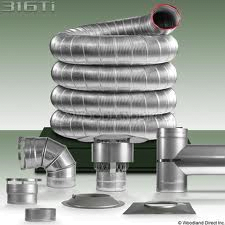 What is chimney lining?
What is chimney lining?
The liner is the channel that all smoke and gases pass through to exit your home. The chimney liner is inside the chimney and should be a separate component of the chimney construction. The inside of your chimney needs to be covered with a non-combustible lining that can vent the toxic hot gases and particles produced by your fireplace, stove or furnace. These linings can be made of stainless steel, casted masonry material, clay tiles or aluminum. The flue, or the channel that the chimney is vented through must be free of any cracks, holes or deterioration to keep your system running safely and efficiently. Any breeches in the integrity of the lining can allow combustible materials that travel up the flue to enter into attics, ceilings or walls adjacent to the chimney.
Our chimney inspection and chimney sweep experts will look at the chimney liner in your chimney very closely.This is one of the most important components of the whole system. If the chimney liner is deficient it can lead to many serious problems.
What are signs that my chimney lining may be in trouble?
If the draft is reduced in your chimney it will lose the power to draw the smoke out and away from your living area. So any smoke or gases in the home indicates a problem. Smelly fireplaces can also indicate a large build-up of creosote and soot, possibly signaling a liner issue as well. Remember, the inside of your chimney needs to be maintained. Proper cleaning and repairs made over the life of your chimney will prevent more costly fixes and dangers that arise from neglect. The sulfur in soot can get wet and become corrosive even to metal liners causing small pinholes to develop over time. A proper cap can prevent much of this damage. Clay linings can chip and flake over the years and start to develop cracks and gaps. A proper inspection will apprise you of the condition of the liner and your certified chimney sweep is the one who will make the recommendation about when it is time to replace or repair your lining. Don’t leave it to your fuel man or heating contractor, that is not their job.
Chimney lining requirements
If you are converting to a new furnace, appliance or type of fuel, you need to make sure that the liner that is installed matches the venting output requirements of the new system. Many times a damaged or deteriorating chimney can be repaired from the inside by installing a new lining (or relining). Wind damage, age settling and lightning may have damaged your chimney and relining can sometimes be the solution for you. Remember, the number one cause of chimney fires is linings that have failed. Many older chimneys may not even have a safe lining at all! These chimneys can still be upgraded by adding a new chimney lining. The cost of tearing apart a weak chimney and rebuilding it entirely can be prohibitive for many homeowners, but a chimney relining can resolve many hazardous conditions and add life to your old chimney.
The NFPA (National Fire Protection Association) code requires masonry chimneys to have a liner. When we inspect your chimney we will recommend the best choice for your individual situation and tell you the reasons behind our suggestions.
Types of Chimney Liners
Tile Liners
If your chimney is fairly short and straight it may be a good candidate for a tile liner. This method is quite common with new construction and is one of the more economical solutions. Clay tile liners are also found in many older homes with masonry chimneys. Unfortunately, once these older tiles deteriorate – retiling may be quite difficult.
Stainless Steel Liners Woodstoves and some types of furnaces may require a stainless steel liner to meet their recommended venting requirements. A round steel liner is inserted down the chimney and serves as your flue pipe. The material can be rigid or flexible depending on the particular chimney specifications that the chimney liner is going in. Chimneys with jogs or offsets will need a flexible solution to fit around the landscape inside the flue area. Heavier liners are generally made of 316L stainless steel, while the lighter varieties are made with 316ti stainless steel (contains titanium). Titanium adds protection from corrosion and high temperatures. Most all stainless steel liners can withstand extremely high heat, making them a good choice.
The newest technology in the chimney industry is called the Stainless Steel Smooth Wall Chimney Liner. This ingenious liner combines the convenience of a Flexible Chimney Liner with the improved performance of a Rigid Chimney Liner. The M-Flex Stainless Steel Smooth wall liner has a double wall construction using the highest quality of 316L/Ti Stainless Steel. Although a little more expensive, the Smooth Wall Liner is more flexible than any other liner we sell and offers the best performance by giving you 20% more draft/Flow than the standard Flex Liners while using all of the same high quality components.
Aluminum Liners Certain types of gas appliances can use aluminum liners which are similar to stainless steel configurations. These liners are not appropriate for most common applications or wood burning fireplaces

